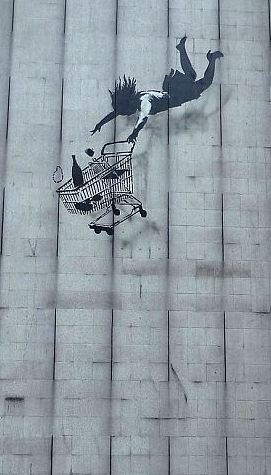
Banksy is an indispensable player in the 21st century art scene. His work is first and foremost a form of protest and cultural resistance. He attempts to bypass the galleries, museums and auction houses that serve as the art world’s primary economic and institutional infrastructure. Although art is his weapon he critiques the art establishment harshly and with a clear distain. His work is seen by many as graffiti, which Banksy describes as “one of the few tools you have if you have almost nothing.” To understand Banksy’s art you must consider its subject matter and location. Topics include serious social issues such as war, violence, surveillance, and political or economic oppression. His pieces are located strategically in major cities throughout the world. Many of his works get removed or painted over because he does not seek permission to place his work on others’ property. As a result, and quite ironically, some of his most iconic works, such as “Girl with Balloon,” now only exist as limited addition prints.
One of the themes in Banksy’s work is exposing the demons of consumerism and consumption. He suggests that our true values are being replaced by a torrent of marketing messages that relentlessly assail us. He continues, “A lot of what surrounds us is not real at all…events, holidays, which play integral roles in our lives, are invented by marketers in order to solve certain economic problems. The capitalistic system urges us to fill the subjective feeling of inner emptiness and loneliness with buying more and more things…in the end we lose our freedom.” The work shown here appears in the upscale Mayfair neighborhood of London. It depicts a girl falling to her imminent death while clinging to her shopping cart. This work was coupled with another mural that appeared at the same time on an abandoned building near the financial district that read “Sorry! The lifestyle you ordered is currently out of stock.” Consuming stuff can certainly provide temporary comfort, but what are we giving up to get it?
